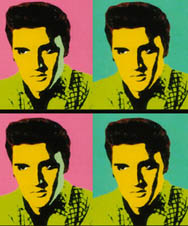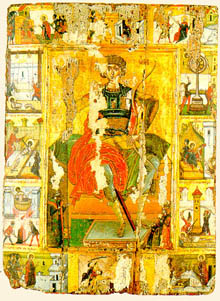 I have not seen the new Ric Burns documentary “Andy Warhol: A Documentary Film,” now ending a two-week run at one New York theater. But The New York Times said the film’s most significant contribution (from an art critic’s standpoint) was the linking of Warhol’s serial portraits of Marilyn Monroe, Liz Taylor, Elvis Presley, et al to “the grid portraying the images of saints that Warhol encountered as a child in a Catholic church, where he spent many hours a week.”
I have not seen the new Ric Burns documentary “Andy Warhol: A Documentary Film,” now ending a two-week run at one New York theater. But The New York Times said the film’s most significant contribution (from an art critic’s standpoint) was the linking of Warhol’s serial portraits of Marilyn Monroe, Liz Taylor, Elvis Presley, et al to “the grid portraying the images of saints that Warhol encountered as a child in a Catholic church, where he spent many hours a week.” 
Grid? What grid? I wrote Beliefnet senior religion editor Laura Sheahen and Beliefnet contributor Frederica Mathewes-Green (who happens to be an expert in Christian iconography) to ask them what saintly line-up Warhol was likely to have seen as a kid. Here are their wonderful responses.
From Sheahen: “I imagine the Warhol grid may have been based on what’s called an iconostasis. It’s a screen covered with saints’ icons and it is found in Orthodox and Eastern Rite (Byzantine) Catholic churches. I just did a quick Google search and found out that Warhol is descended from Carpatho-Russians in Slovakia, so it’s likely he would have encountered iconostases in his youth. Here (scroll down) and here are are examples.”
From Mathewes-Green, upon reading what Sheahen wrote: “That’s a good description of an iconostasis; it’s the screen that stands (stasis) between the congregation and the altar, covered with icons: a central door, Christ to the right of it and the Virgin to the left, and other saints in all directions. There is a large bottom row and one or even two or three rows above, with smaller icons, a set pattern–one row is for apostles, one row for Old Testament saints, etc. Here’s a “map” of an iconostasis. But I suspect what Warhol meant was a single icon that showed a number of different images at once. One might show many different saints–for example, a “menaion,” or month, would show all the saints whose feasts are in a given month, with their postage-stamp images in a literal grid. Here’s a 16th century icon for February, which begins with the presentation of Christ in the temple, and continues with portraits of saints celebrated that month.
“Since Warhol repeated the image of the same person, however, maybe it is more like an icon of a saint that shows scenes from the saint’s life–usually one big portrait icon in the middle, and smaller chronological icons depicting life events and miracles around the four sides. Here’s a life icon of St George.”
